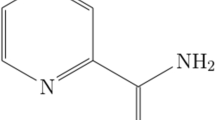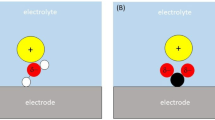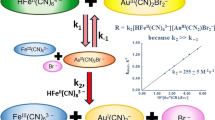Abstract
The protonation constants of 5,10,15,20-tetrakis(4-sulfonatophenyl)porphyrin, H2tpps4−, were determined in water–ethanol and water–methanol mixed solvents, using a combination of spectrophotometric and potentiometric methods at 20 °C and 0.1 mol⋅dm−3 sodium perchlorate as supporting electrolyte. Two protonation constants, K 1 and K 2, were characterized and were analyzed in various media in terms of the Kamlet, Abboud and Taft (KAT) parameters. Single-parameter correlations of the protonation constant K 1 versus α (hydrogen-bond donor acidity) and π * (dipolarity/polarizability) are poor in all solutions, but dual-parameter (α and π *) correlation represents a significant improvement with regard to the single- and multi-parameter models. However, the single-parameter correlation of log 10 K 2 in terms of β (hydrogen-bond acceptor basicity) shows a better result than dual- and multi-parameter correlations. Linear correlation is observed when the experimental log 10 K 1 and log 10 K 2 values are plotted versus the calculated ones when the KAT parameters are considered. To evaluate the protonation constants of H2tpps4−, the Yasuda-Shedlovsky extrapolation is used to obtain the log 10 K 1 and log 10 K 2 values at zero percent organic solvent. Finally, the results are discussed in terms of the effect of the solvent on protonation.
Similar content being viewed by others

References
Rothemund, P.: A new porphyrin synthesis. The synthesis of porphin. J. Am. Chem. Soc. 58, 625–627 (1936)
Longo, F.R., Brown, E.M., Rew, W., Adler, A.D.: The Porphyrins. Academic Press, New York (1980)
Lavallee, D.K.: Kinetics and mechanisms of metalloporphyrin reactions. Coord. Chem. Rev. 61, 55–96 (1985)
Brault, D.: Physical chemistry of porphyrins and their interactions with membranes: the importance of pH. J. Photochem. Photobiol. B, Biol. 6, 79–86 (1990)
Makino, T.: A simple and sensitive colorimetric assay of zinc in serum using cationic porphyrin. Clin. Chim. Acta 282, 65–76 (1999)
Milgrom, L.R.: The Colors of Life: An Introduction to the Chemistry of Porphyrins and Related Compounds. Oxford University Press, Oxford (1997)
Engst, P., Kubat, P., Jirsa, M.: The influence of D2O on the photophysical properties of meso-tetra (4-sulphonatophenyl) porphine, Photosan III and tetrasulphonated aluminium and zinc phthalocyanines. J. Phochem. Photobiol. A, Chem. 78, 215–219 (1994)
Mosinger, J., Deumie, M., Lang, K., Kubat, P., Wagnerova, D.M.: Supramolecular sensitizer: Complexation of meso-tetrakis(4-sulfonatophenyl)porphyrin with 2-hydroxypropyl-cyclodextrins. J. Photochem. Photobiol. A, Chem. 130, 13–20 (2000)
Cunderlikova, B., Gangeskar, L., Moan, J.: Acid-base properties of chlorin e6: relation to cellular uptake. J. Photochem. Photobiol. B, Biol. 53, 81–90 (1999)
Tannock, I.F., Rotin, D.: Acid pH in tumors and its potential for therpeutic exploitation. Cancer Res. 49, 4373–4384 (1989)
Wike-Hooley, J.L., Haveman, J., Reinhold, J.S.: The relevance of tumour pH to the treatment of malignant disease. Radiother. Oncol. 2, 343–366 (1984)
Brunner, H., Arndt, M.R., Treittinger, B.: Porphyrin platinum conjugates—new aims. Inorg. Chim. Acta 357, 1649–1669 (2004)
Fleischer, E.B., Palmer, J.M., Srivastava, T.S., Chatterjee, A.: Thermodynamic and kinetic properties of an iron porphyrin system. J. Am. Chem. Soc. 93, 3162–3165 (1971)
Gameiro, P., Reis, S., Lima, J.L.F.C., de Castro, B.: Calibration of pH glass electrodes by direct strong acid/strong base titrations under dilute conditions. Anal. Chim. Acta 405, 167–172 (2000)
Jaime-Ferrer, J.S., Couallier, E., Rakib, M., Durand, G.: Electrochemical determination of acidity level and dissociation of formic acid/water mixtures as solvent. Electrochim. Acta 52, 5773–5780 (2007)
Beltran, J.L., Codony, R., Prat, M.D.: Evaluation of stability constants from multi-wavelength absorbance data: program STAR. Anal. Chim. Acta 276, 441–454 (1993)
Pasternack, R.F., Francesconi, L., Raff, D., Spiro, E.: Aggregation of nickel(II), copper(II), and zinc(II) derivatives of water-soluble porphyrins. J. Am. Chem. Soc. 95, 2606–2611 (1973)
Satteriee, I.D., Shelnutt, A.: Studies of urohemin-I in aqueous-solution, thermodynamics of self-association and elerctronic-propertities of 2 species detected by proton nmr-spectroscopy. J. Phys. Chem. 88, 5487–5492 (1984)
Chandrashekar, T.K., Van-Willigen, H., Ebersole, M.H.: Optical and electron-spin resonance study of cation and cation crown ether induced dimerization of tetrakis(4-sulfonatophenyl)porphyrin. J. Phys. Chem. 88, 4326–4332 (1984)
Kano, K., Nakajima, T., Takei, M., Hashimoto, S.: Self aggregation of cationic porphyrin in water. Bull. Chem. Soc. Jpn. 60, 1281–1287 (1987)
Beck, M.T., Nagypal, I.: Chemistry of Complex Equilibria. Ellis Harwood, New York (1990)
Farajtabar, A., Gharib, F., Jamaat, P., Safari, N.: Complexation of 5,10,15,20-tetrakis(4-sulfonatophenyl)porphyrin with zinc(II) ions in aqueous solution. J. Chem. Eng. Data 53, 350–354 (2008)
Tabata, M., Tanaka, M.: A new method for the determination of the stability constant of metalloporphyrins, use of the catalytic effect of mercury(II) on metalloporphyrin formation. J. Chem. Soc. Chem. Commun., 42–43 (1985)
Okumura, R., Hinoue, T., Watarai, H.: Ion-association adsorption of water-soluble porphyrin at a liquid-liquid aqueous systems. Anal. Sci. 12, 393–397 (1996)
Mohajer, D., Zakavi, S., Rayati, S., Zahedi, M., Safari, N., Khavasi, H.R., Shahbazian, S.: Unique 1:2 adduct formation of meso-tetraarylporphyrins and meso-tetraalkylporphyrins with BF3: spectroscopic and ab initio study. New J. Chem. 28, 1600–1607 (2004)
Baker, H., Wagner, L., Hambright, P.: Metal ion porphyrin interactions. Evidence for nonexistence of sitting atop complexes in aqueous solution. J. Am. Chem. Soc. 95, 5942–5946 (1973)
Barbosa, J., Barron, D., Beltran, J.L., Buti, S.: On the role of solvent in acid–base equilibria of diuretics in acetonitrile–water mixed solvents. Talanta 45, 817–827 (1998)
Barbosa, J., Toro, I., Sanz-Nebot, V.: Acid-base behavior of tripeptides in solvent used in liquid chromatography. Correlation between pK values and solvatochromic parameters of acetonitrile-water mixtures. Anal. Chim. Acta 347, 295–304 (1997)
Demirelli, H.: On the role of the solvent and substituent on the protonation equilibria of di-substituted anilines in dioxane-water mixed solvents. J. Sol. Chem. 34, 1283–1295 (2005)
Isutsu, K.: Electrochemistry in Nonaqueous Solutions. Wiley-VCH, Weinheim (2002)
Reichardt, C.: Solvents and Solvent Effects in Organic Chemistry, 3rd edn. Wiley-VCH, Weinheim (2004)
Taft, R.W., Abboud, J.L.M., Kamlet, M.J.: Linear solvation energy relationships. 28. An analysis of Swain’s solvent “acidity” and “basicity” scales. J. Org. Chem. 49, 2001–2005 (1984)
Kamlet, M.J., Abboud, J.L.M., Abraham, M.H., Taft, R.W.: Linear solvation energy relationships. 23. A comprehensive collection of the solvatochromic parameters, π *,α, and β, and some methods for simplifying the generalized solvatochromic equation. J. Org. Chem. 48, 2877–2887 (1983)
Gharib, F., Jabbari, M., Farajtabar, A., Shamel, A.: Solvent effects on protonation and complexation of glutamic and aspartic acids with molybdenum(VI) in different aqueous solutions of methanol. J. Chem. Eng. Data 53, 1772–1778 (2008)
Gharib, F.: Solvent effects on complexation of dioxovanadium(V) with penicillamine in methanol-water mixtures. J. Chem. Eng. Data 50, 196–200 (2005)
Gharib, F., Sadeghi, F.: Solvent Effects on complexation of thallium(I) with guanosine 5′-monophosphate in methanol-water mixtures. Appl. Organomet. Chem. 21, 218–225 (2007)
Maleki, N., Haghighi, B., Safavi, A.: Evaluation of formation constants, molar absorptivities of metal complexes, and protonation constants of acids by nonlinear curve fitting using Microsoft Excel Solver. Micochem. J. 62, 229–236 (1999)
Buhvestov, U., Rived, F., Rafols, C., Bosch, E., Roses, M.: Solute-solvent and solvent-solvent interactions in binary solvent mixtures, part 7: comparison of the enhancement of the water structure in alcohol-water mixtures measured by solvatochromic indicators. J. Phys. Org. Chem. 11, 185–192 (1998)
Akerlof, G.: Dielectric constants of some organic solvent-water mixtures at various temperatures. J. Am. Chem. Soc. 54, 4125–4139 (1932)
Moger, G.: Solvent effect on the dissociation constants and Soret band maxima of hematoporphyrin diacid. React. Kinet. Catal. Lett. 54, 329–336 (1995)
Barbosa, J., Fonrodona, G., Marques, I., Buti, S., Toro, I.: Factor analysis applied to the correlation between dissociation constants and solvatochromic parameters in water-acetonitrile mixtures, II: Study of solvent effects on the dissociation of functional groups of diuretics, quinolones, buffers and peptides. Trends Anal. Chem. 16, 104–111 (1997)
Yasuda, M.: Dissociation constants of some carboxylic acids in mixed aqueous solvents. Bull. Chem. Soc. Jpn. 32, 429–432 (1959)
Shedlovsky, T.: In: Peasce, B. (ed.) Electrolytes. Pergamon, New York (1962)
Ruiz, R., Rrafols, C., Roses, M., Bosch, E.: A potentially simpler approach to measure aqueous pK a of insoluble basic drugs containing amino groups. J. Pharm. Sci. 92, 1473–1481 (2003)
Avdeef, A., Box, K.J., Comer, J.E.A., Gilges, M., Hadley, M., Hibbert, C., Patterson, W., Tam, K.Y.: PH-metric log P11. pK(a) determination of water-insoluble drugs in organic solvent-water mixtures. J. Pharm. Biomed. Anal. 20, 631–641 (1999)
Author information
Authors and Affiliations
Corresponding author
Rights and permissions
About this article
Cite this article
Farjtabar, A., Gharib, F. Solvent Effect on Protonation Constants of 5, 10, 15, 20-Tetrakis(4-sulfonatophenyl)porphyrin in Different Aqueous Solutions of Methanol and Ethanol. J Solution Chem 39, 231–244 (2010). https://doi.org/10.1007/s10953-010-9496-y
Received:
Accepted:
Published:
Issue Date:
DOI: https://doi.org/10.1007/s10953-010-9496-y



